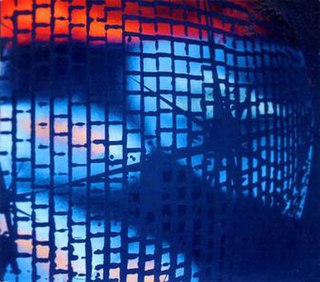Ambient techno is a subgenre of techno that incorporates the atmospheric textures of ambient music with the rhythmic elements and production of techno. It was pioneered by 1990s electronic artists such as Aphex Twin, Carl Craig, The Orb, The Future Sound of London, the Black Dog, Pete Namlook and Biosphere.

Vladislav Delay is the most frequently used pseudonym of Sasu Ripatti, a Finnish electronic musician. He has also recorded as Luomo, Sistol, Uusitalo,Conoco, and Ripatti, working in styles such as minimal techno, glitch, and house.
Jan Jelinek is a German electronic musician who also operates under the names Farben, Gramm and The Exposures. His music is usually categorized as minimal techno, glitch or microhouse, and is characterized by deep basslines, extensive use of samples from earlier jazz and rock recordings, and clicks & cuts effects. He is the founder of the German record label Faitiche.

Marc Leclair, better known by his stage name Akufen, is a Canadian electronic musician. His music is electronic music that is often described as minimal house, minimal techno, glitch, or microhouse.
Minimal techno is a subgenre of techno music. It is characterized by a stripped-down aesthetic that exploits the use of repetition and understated development. Minimal techno is thought to have been originally developed in the early 1990s by Detroit-based producers Robert Hood and Daniel Bell.
Ghostly International is an American independent record label founded in 1999 by Samuel Valenti IV and currently headquartered in Brooklyn, New York City. Chief artists include Matthew Dear, Dabrye, Com Truise, Tycho, Gold Panda, School of Seven Bells, Mux Mool, and Shigeto.
Bigod 20 was a German EBM-techno band which was formed in 1988 by music producers Andreas Tomalla and Markus Nikolai. Nikolai, together with Thomas Franzmann, run the Berlin based Perlon record label.

Ricardo Villalobos is a Chilean-born German electronic music producer and DJ. He is well known for his work in the minimal techno and microhouse genres, and is one of the most significant figures in the minimal techno scene.
Mille Plateaux is a German record label founded in 1994 by Achim Szepanski in Frankfurt, as a sublabel of Force Inc. Music Works. Its releases in the fields of minimal techno, glitch music and other experimental electronic music have a lasting influence.
Hard NRG, nu-NRG, filthy hard house, or more recently just filth, is an electronic dance music genre similar in structure to UK hard house form, taking influences from German hard trance. The main difference is in the musical/thematic content of each style.

Rajko Müller, better known by his stage name Isolée, is a German electronic music producer. He is noted for his work in the microhouse genre, reminiscent of indie electronic pop music of the early eighties and ambient techno from a decade on. Isolée is credited with creating the very first microhouse record to reach the club charts. Isolée's 2000 album Rest, containing the hit "Beau Mot Plage", was arguably the first microhouse full-length.
Perlon is an electronic music record label founded in 1997 in Frankfurt, Germany, now based in Berlin, and run by Thomas Franzmann aka Zip and Markus Nikolai. It is a minimal techno and tech house label which has been characterised as one of the most influential German dance music labels. Its catalogue features music by producers such as A Guy Called Gerald, Akufen, Ricardo Villalobos, Baby Ford, Dandy Jack, Luciano, Matt John, Pantytec, Stefan Goldmann and Thomas Melchior. It is mostly a vinyl label, apart from compilations and some artist albums released on CD. No releases have been made available online in digital formats.

Vocalcity is an album by Finnish electronic music producer Sasu Ripatti, better known as Vladislav Delay, and the first to be released under his stage name Luomo. It was released on 23 May 2000 on Force Tracks, and was reissued in 2005 on Ripatti's label Huume.

Hendrik Weber, better known as Pantha du Prince, Panthel, and Glühen 4 is a German producer, composer and conceptual artist for electro, techno, house, minimal, and noise, affiliated with Dial Records, and Rough Trade Records.

Gas is the main musical project of German electronic musician and composer Wolfgang Voigt. The project was created as an expressive medium inspired by his experiences with taking LSD in the Königsforst, a German forest situated near his hometown of Cologne, for long periods in his youth. He has claimed that the intention of the project is to "bring the forest to the disco, or vice-versa".

Robert Babicz is a Polish-born music producer, mastering engineer and live performer living in Malta. With a career spanning nearly three decades covering genres from techno to acid house to minimal, Robert has also been known under the pseudonyms Rob Acid, Acid Warrior, Department of Dance and Sontec amongst many others. He has released a number of well respected records on labels such as Kompakt, Systematic Recordings, Treibstoff, Bedrock, Intec Digital and Steve Bug's Audiomatique, as well his own labels, Junkfood, Babiczstyle and Dirtcut. He is well known as a live performer rather than a DJ, as he uses synths and live equipment and improvises in every set he plays.
Kenneth James Gibson is a musician, record producer, composer, singer, songwriter and a founding member of Bell Gardens, Furry Things, Eight Frozen Modules, and [a]pendics.shuffle.

BFORD 9 is the third studio album by English house producer Baby Ford, released in 1992 by Insumision Records in the United Kingdom and by Sire Records in the United States. Ford co-produced the album with Richard Salt. Dispirited by hardcore music and the contemporary house scene, Ford decided to create an album that explored moods and emotions, while combining elements of his acid house work. The resulting album is eclectic and explores styles of techno, funk and disco, as well as featuring Ford's soft vocals.